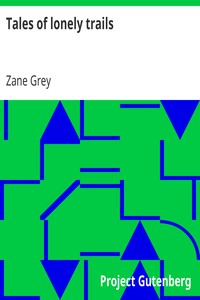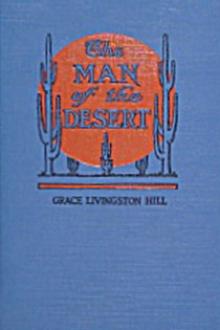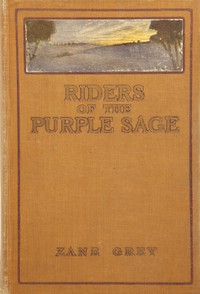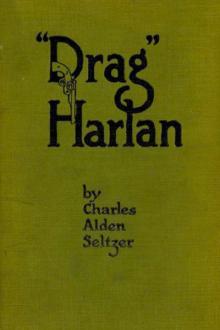Tales of lonely trails, Zane Grey [best ebook reader for chromebook .txt] 📗

- Author: Zane Grey
Book online «Tales of lonely trails, Zane Grey [best ebook reader for chromebook .txt] 📗». Author Zane Grey
We got over that bad place without further incident, and presently came to a long swell of naked stone that led down to a narrow green split. This one had straight walls and wound away out of sight. It was the head of a canyon.
"Nonnezoshe Boco," said the Indian.
This then was the Canyon of the Rainbow Bridge. When we got down into it we were a happy crowd. The mode of travel here was a selection of the best levels, the best places to cross the brook, the best places to climb, and it was a process of continual repetition. There was no trail ahead of us, but we certainly left one behind. And as Wetherill picked out the course and the mustangs followed him I had all freedom to see and feel the beauty, color, wildness and changing character of Nonnezoshe Boco.
My experiences in the desert did not count much in the trip down this strange, beautiful lost canyon. All canyons are not alike. This one did not widen, though the walls grew higher. They began to lean and bulge, and the narrow strip of sky above resembled a flowing blue river. Huge caverns had been hollowed out by water or wind. And when the brook ran close under one of these overhanging places the running water made a singular indescribable sound. A crack from a hoof on a stone rang like a hollow bell and echoed from wall to wall. And the croak of a frog—the only living creature I noted in the canyon—was a weird and melancholy thing.
"We're sure gettin' deep down," said Joe Lee.
"How do you know?" I asked.
"Here are the pink and yellow sego lilies. Only the white ones are found above."
I dismounted to gather some of these lilies. They were larger than the white ones of higher altitudes, of a most exquisite beauty and fragility, and of such rare pink and yellow hues as I had never seen.
"They bloom only where it's always summer," explained Joe.
That expressed their nature. They were the orchids of the summer canyons. They stood up everywhere star-like out of the green. It was impossible to prevent the mustangs treading them under foot. And as the canyon deepened, and many little springs added their tiny volume to the brook, every grassy bench was dotted with lilies, like a green sky star-spangled. And this increasing luxuriance manifested itself in the banks of purple moss and clumps of lavender daisies and great mounds of yellow violets. The brook was lined by blossoming buck-brush; the rocky corners showed the crimson and magenta of cactus; and there were ledges of green with shining moss that sparkled with little white flowers. The hum of bees filled the fragrant, dreamy air.
But by and bye, this green and colorful and verdant beauty, the almost level floor of the canyon, the banks of soft earth, the thickets and clumps of cottonwood, the shelving caverns and bulging walls—these features were gradually lost, and Nonnezoshe began to deepen in bare red and white stone steps. The walls sheered away from one another, breaking into sections and ledges, and rising higher and higher, and there began to be manifested a dark and solemn concordance with the nature that had created this old rent in the earth.
There was a stretch of miles where steep steps in hard red rock alternated with long levels of round boulders. Here, one by one, the mustangs went lame and we had to walk. And we slipped and stumbled along over these loose, treacherous stones. The hours passed; the toil increased; the progress diminished; one of the mustangs failed and was left. And all the while the dimensions of Nonnezoshe Boco magnified and its character changed. It became a thousand-foot walled canyon, leaning, broken, threatening, with great yellow slides blocking passage, with huge sections split off from the main wall, with immense dark and gloomy caverns. Strangely it had no intersecting canyons. It jealously guarded its secret. Its unusual formations of cavern and pillar and half-arch led me to expect any monstrous stone-shape left by avalanche or cataclysm.
Down and down we toiled. And now the stream-bed was bare of boulders and the banks of earth. The floods that had rolled down that canyon had here borne away every loose thing. All the floor, in places, was bare red and white stone, polished, glistening, slippery, affording treacherous foothold. And the time came when Wetherill abandoned the stream-bed to take to the rock-strewn and cactus-covered ledges above.
The canyon widened ahead into a great ragged iron-lined amphitheater, and then apparently turned abruptly at right angles. Sunset rimmed the walls.
I had been tired for a long time and now I began to limp and lag. I wondered what on earth would make Wetherill and the Indians tired. It was with great pleasure that I observed the giant Joe Lee plodding slowly along. And when I glanced behind at my straggling party it was with both admiration for their gameness and glee for their disheveled and weary appearance. Finally I got so that all I could do was to drag myself onward with eyes down on the rough ground. In this way I kept on until I heard Wetherill call me. He had stopped—was waiting for me. The dark and silent Indian stood beside him, looking down the canyon.
I saw past the vast jutting wall that had obstructed my view. A mile beyond, all was bright with the colors of sunset, and spanning the canyon in the graceful shape and beautiful hues of the rainbow was a magnificent natural bridge.
"Nonnezoshe," said Wetherill, simply.
This rainbow bridge was the one great natural phenomenon, the one grand spectacle which I had ever seen that did not at first give vague disappointment, a confounding of reality, a disenchantment of contrast with what the mind had conceived.
But this thing was glorious. It absolutely silenced me. My body and brain, weary and dull from the toil of travel, received a singular and revivifying freshness. I had a strange, mystic perception that this rosy-hued, tremendous arch of stone was a goal I had failed to reach in some former life, but had now found. Here was a rainbow magnified even beyond dreams, a thing not transparent and ethereal, but solidified, a work of ages, sweeping up majestically from the red walls, its iris-hued arch against the blue sky.


Then we plodded on again. Wetherill worked around to circle the huge amphitheater. The way was a steep slant, rough and loose and dragging. The rocks were as hard and jagged as lava, and cactus hindered progress. Soon the rosy and golden lights had faded. All the walls turned pale and steely and the bridge loomed dark.
We were to camp all night under the bridge. Just before we reached it Nas ta Bega halted with one of his singular motions. He was saying his prayer to this great stone god. Then he began to climb straight up the steep slope. Wetherill told me the Indian would not pass under the arch.
When we got to the bridge and unsaddled and unpacked the lame mustangs twilight had fallen. The horses were turned loose to fare for what scant grass grew on bench and slope. Firewood was even harder to find than grass. When our simple meal had been eaten there was gloom gathering in the canyon and stars had begun to blink in the pale strip of blue above the lofty walls. The place was oppressive and we were mostly silent.
Presently I moved away into the strange dark shadow cast by the bridge. It was a weird black belt, where I imagined I was invisible, but out of which I could see. There was a slab of rock upon which I composed myself, to watch, to feel.
A stiffening of my neck made me aware that I had been continually looking up at the looming arch. I found that it never seemed the same any two moments. Near at hand it was too vast a thing for immediate comprehension. I wanted to ponder on what had formed it—to reflect upon its meaning as to age and force of nature. Yet it seemed that all I could do was to see. White stars hung along the dark curved line. The rim of the arch appeared to shine. The moon was up there somewhere. The far side of the canyon was now a blank black wall. Over its towering rim showed a pale glow. It brightened. The shades in the canyon lightened, then a white disk of moon peeped over the dark line. The bridge turned to silver.
It was then that I became aware of the presence of Nas ta Bega. Dark, silent, statuesque, with inscrutable face uplifted, with all that was spiritual of the Indian suggested by a somber and tranquil knowledge of his place there, he represented to me that which a solitary figure of human life represents in a great painting. Nonnezoshe needed life, wild life, life of its millions of years—and here stood the dark and silent Indian.
Long afterward I walked there alone, to and fro, under the bridge. The moon had long since crossed the streak of star-fired blue above, and the canyon was black in shadow. At times a current of wind, with all the strangeness of that strange country in its moan, rushed through the great stone arch. At other times there was silence such as I imagined might have dwelt deep in the center of the earth. And again an owl hooted, and the sound was nameless. It had a mocking echo. An echo of night, silence, gloom, melancholy, death, age, eternity!
The Indian lay asleep with his dark face upturned, and the other sleepers lay calm and white in the starlight. I seemed to see





Comments (0)